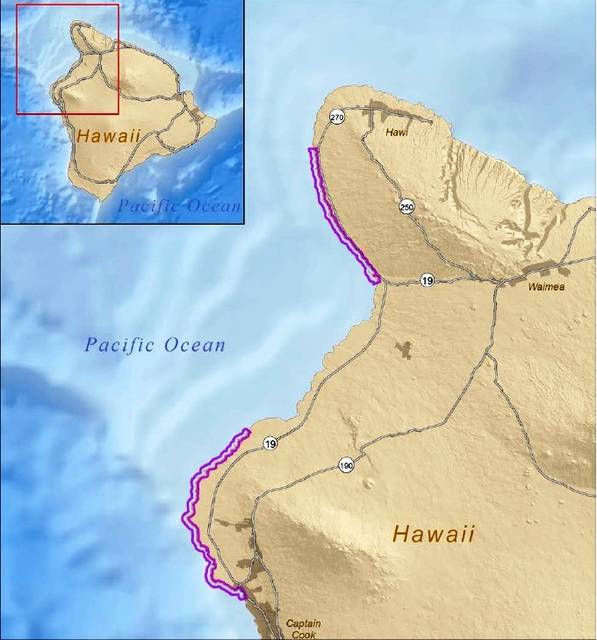There soon could be marine life of a different sort off the West Hawaii coast, as military units prepare to train by air, land and sea next year.
The public has until Dec. 10 to comment on a proposal by the U.S. Naval Special Warfare Command to conduct joint special operations training in West Hawaii and elsewhere in the state. The training includes naval as well as Army, Air Force and U.S. Marine Corps special ops forces.
A draft environmental assessment published Thursday anticipates no significant environmental impact from the training exercises that are scheduled to start in 2019.
Water-based training will consist of swimming and diving, launching and recovering submersible small vehicles and inserting and extracting special ops personnel using watercraft.
Land-based training includes personnel crossing the beach on foot, simulating building clearance activities using simulated munitions, engaging in high angle climbing and using observation techniques in special reconnaissance role-playing scenarios.
Air-based training includes unmanned aircraft systems or aircraft using drop zones or landing zones for parachute or rope suspension training activities.
Training would occur in the nearshore waters and land-based areas on Oahu, Hawaii Island and Kauai, and in nearshore waters, including harbors and bays, of Maui, Molokai and Lanai.
On Hawaii Island, training will be conducted along part of the South Kohala and North Kohala coasts, approximately from Mahukona in North Kohala to just south of Kawaihae in South Kohala. Training also is planned in North Kona from Kukio Bay to about Waiaha Bay, south of Kailua Bay.
Jim Albertini, founder of the Malu Aina Center for non-violent education and action, contacted for a comment, said he hadn’t yet read the full 249-page draft environmental assessment. But some of the land-based activities described in the executive summary used the exact language as that in another notice he just received about special reconnaissance role-playing scenarios to be conducted near Maunakea county park, he said.
“It’s outrageous. It appears the Navy now wants to expand operations and conduct armed covert special ops in our Maunakea county park and on the slopes of Maunakea,” Albertini said. “I say no way. The military needs to clean up the toxic messes all over Hawaii, not expand their training into our parks and on the slopes of sacred Maunakea.”
A call to the Naval Facilities Engineering Command Pacific public affairs office Monday, a government holiday, was not returned by press deadlines.
The training activities would not restrict the ability of individuals to use or access recreational areas. Nor are the activities expected to cause harassment or taking of marine mammals, the EA says.
The activities “may affect but would not adversely affect” five Endangered Species Act-listed plant species and associated critical habitat for two of the species including orangeblack damselfly, two yellow-faced bee species, Hawaiian coot, Hawaiian common gallinule, Hawaiian duck, Hawaiian stilt, Hawaiian goose, Hawaiian hawk, band-rumped storm petrel, Hawaiian petrel, Newell’s Townsend’s shearwater, Hawaiian hoary bat, oceanic whitetip shark, giant manta ray, green turtle, hawksbill turtle, olive ridley turtle, Hawaiian monk seal and associated critical habitat, blue whale (Central North Pacific Stock), Main Hawaiian Islands Insular false killer whale and associated critical habitat, fin whale, sei whale and sperm whale, according to the EA.
The draft environmental assessment contemplates two alternatives as well as a no-action alternative.
Under the preferred alternative, each non-federal training site would be used for a maximum of 10 events per year, pending receipt of real estate agreements or right-of-entry permits, within the training study area. The maximum number of events across all non-federal land training sites would not exceed 330 events. For federal property, up to 265 events would occur per year.
The other alternative would decrease the activity on each non-federal property training site to a maximum of six events per year. The maximum number of events across all non-federal land training sites would not exceed 198 events. Federal property within the training study area would see up to 52 events per year.
The EA can be viewed online at https://go.usa.gov/xUnDC (click on “Environmental Assessment Open for Public Review” at left side of page) and at some public libraries, including the Kailua-Kona Public Library.
Comments can be submitted by email to NFPAC-Receive@navy.mil or by mail to Naval Facilities Engineering Command Pacific, Attention: Project Manager, EV21.JZ, 258 Makalapa Drive, Ste. 100, Pearl Harbor, HI 96860-3134.
Email Nancy Cook Lauer at ncook-lauer@westhawaiitoday.com.






